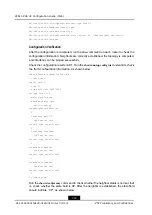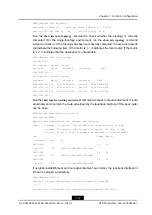
Chapter 8 BGP4+ Configuration
Headers: Dest: Destination, Gw: Gateway, Pri: Priority;
Codes
: K: kernel, I1: isis-l1, SFN: sf-nat64, R: ripng, AF: aftr, B: bgp,
D: direct, I2: isis-l2, SLN: sl-nat64, O: ospfv3, D6: dhcp, P: ppp,
S: static, N: nd, V: vrrp, A: address, M: multicast, UI: user-ipaddr;
Dest
Owner
Metric
Interface
Pri
Gw
2000:0:0:1::/64
B
0
gei-2/1
20
fe80:12::1
2000:0:0:1::/64
B
0
gei-2/2
20
fe80:16::1
8.3.3 Example: Configuring BGP4+
Configuration Description
This example describes how to configure BGP4+. It involves the practical use of BGP4+,
such as IBGP/EBGP neighbor establishment, routing policy, route redistribution, and
Message Digest 5 Algorithm (
) encryption.
As shown in
, EBGP neighbors are established between R4 and R1, IBGP
neighbors are established between R1 and R2, and multi-hop EBGP neighbors are
established between R2 and R5.
R2 and R5 establish an EBGP multi-hop relation
through R3. Before BGP is configured, it is necessary to ensure that the addresses used
for neighbor establishment between the two routers can interwork with each other (via
IGP; IGP configuration is omitted in this example).
Figure 8-3 BGP4+ General Configuration Example
Configuration Flow
1.
Enable IPv6 on each interface and configure IPv6 addresses.
2.
Create a BGP4+ instance.
3.
Configure BGP4+ neighbors and routing policies.
4.
Configure the redistribution command and enable neighbors to advertise routes.
8-7
SJ-20140504150128-018|2014-05-10 (R1.0)
ZTE Proprietary and Confidential
















































